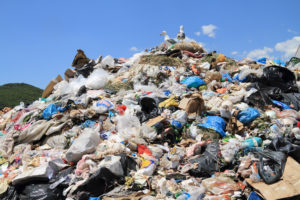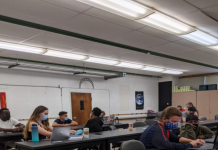“At the beginning of this school year NEC’s recycling rate was at about 12%,” said President of the Environmental Action Committee (EAC) Stephanie Goulet. “We could very easily triple the amount of waste we divert out of landfills just by simply having the [new] system in place.”
After a big push from Goulet and EAC, although recycling has existed at NEC for years, when students returned to the college following winter break they were met with a more holistic recycling system that’s campus-wide.
As a part of this program, residence halls, common spaces, and classrooms now have large blue recycling bins to deposit all recyclable items. This includes: plastic bottles and containers marked #1-7, glass bottles (no lids), aluminum foil, aluminum and steel cans—free of food bits or liquids of any kind, paper, magazines, cardboard boxes, and grocery sacks.
NEC produced 39.29 tons of waste in the month of November alone, approximately 10% of which was recycled, said Assistant V. P. for Capital and Facilities Management, Dan Gearan.
Surprisingly enough, close to 90% of the waste generated in offices is recyclable, Gearan explained, in a mass email announcing the addition of the initiative “TinyTrash@NEC” to the program. This initiative calls on NEC employees to set an example for students. As a part of “Tiny Trash,” staff and faculty offices are being provided small bins to replace the larger cans they previously used. These smaller bins are where all non-recyclables will be disposed of. This includes: napkins, tissues, paper towels, plastic wrap, granola bar and candy bar wrappers, plastic bags, wax paper, and food scraps.
Facilities staff will be in charge of emptying both the recycling and trash bins. But Gearan—who EAC said deserves a huge amount of credit for all the hard work, time, and effort he put into making the concept of a more wide-spread recycling system into a reality—urged community members to empty these bins as needed, especially if they note an excess of use on a particular occasion. Larger communal receptacles will be assigned within buildings for this purpose.
These changes are all a part of a larger goal of NEC’s to increase the recycling rate at the college, thus lessening the amount of trash that reaches landfills, as a strong commitment to the natural environment is a major part of NEC’s Strategic Plan.
“We are working with a number of groups on and off campus to improve sustainability here at the College,” Gearan said. Such groups include: students in EAC, the Sustainability Task Force, consultants at Mobius Resource Management, who communicated with NEC’s waste hauler Naughton & Son Recycling to get additional recycling dumpsters, and NEC alumna Amy Naughton, who worked with Mobius and donated 250 blue office recycling bins and four two-wheel recycling toters for Simon & Spalding.
Gearan said, “We have received a lot of positive feedback while launching the program. Many people are excited the have started this comprehensive effort to recycle more.”
Along with being more environmentally sound, this new program will decrease expenditures on plastic bags, resource waste, and hauling and tipping charges. But “the goal is not so much about saving money,” Gearan said, “as it is about the college becoming more sustainable. While recycling theoretically should cost less, there will be additional dumpster pickups to haul the recycling separately.” While the program is projected to cost a similar amount to the previous program, maybe a little bit less, more importantly, NEC is looking to increase recycling by 300+%.
“EAC is thrilled that NEC has finally taken recycling seriously,” said Goulet. “There were so many people on campus who wanted this to happen for so long and now that it finally has, it’s definitely something to smile about.” But she said there are still kinks that need to be worked out, something that commonly occurs with any new program.
For example, there’s a lack of turnout at floor meetings so several dorm rooms still don’t have a recycling bag. These can be acquired in the duty office of each building (either in West or Charter). So EAC urges all students who live inside the dorms to stop by and pick up a bag for their building.
Individual participation in this program will make a large difference in the amount of waste that’s ‘diverted.’ ‘Diverting’ waste, or redirecting it from a landfill to a recycling center where the materials are reused, along with ‘reducing’ waste, behaviors that prevents materials from reaching any dumpster, such as refilling a water bottle rather than buying a plastic disposable one, are ways we can all have an impact on our environment.
“Most people are surprised that the percentage of material you can recycle is so high,” Goulet said. “Without diverting recyclables, your plastic Mountain Dew bottle would sit uselessly in landfills more than twenty times larger than all of NEC.”

As the program just launched, results are not available to share at this time, but monthly reports by the company hired to negotiate with waste and recycling vendors, Mobius Resource Management, will chart the coming progress.
“Recycling isn’t a new concept;” Goulet said. “People know how to recycle because they already do it everywhere—hometowns, workplaces, at the mall—so I am very optimistic that we can make a big impact just by this one addition.”
But this program is just the beginning for EAC, who’s always looking for more student members who feel passionately about getting involved, and is happy to share with the community that they have a few different projects already in the works.
“The one I am personally most excited for,” Goulet said, “is to divest New England College from fossil fuels. Although this project is still in its infancy, we have received such positive support from other students that it has made our dedication to this cause that much stronger.”
The realization of this new program has provided EAC with hope that in the future NEC’s commitment to the natural environment will be shown consistently in their decisions.






















I was excited for this initially. At long last, we were going to recycle at NEC! But has anyone else noticed how they actually take out the trash? I’ve seen custodians empty both the trash and the recycling into the same larger bag for removal. If the garbage and the recyclables end up in the same bag, then how are they able to recycle the previously sorted items if it becomes unsorted again?